Back pain and neck pain are one of the most common reasons to see a doctor. Pain is usually caused by problems with the musculoskeletal system - more often with problems with the spine, including the spine (vertebrae), discs and the muscles and ligaments that support them. Sometimes back pain is caused by a condition that does not affect the musculoskeletal system.
Low back pain is more common in older age groups and affects more than half of people over the age of 60. It incurs significant costs in terms of health payments, disability benefits and missed working hours.
The spine consists of vertebrae. There are shock absorber discs between the vertebrae. The discs have a hard outer fibrocartilaginous tissue layer and a soft, jelly-like inner substance called the nucleus. Each vertebra has two joints behind the discs. These joints are called facet joints. One vertebral body forms a joint by extending to the joint surfaces below the joint surfaces. Stabilized by joints and with them all the spine, ligaments and muscles, namely:
- Two iliopsoas muscles extending on either side of the spine
- Two vertical back muscles that extend the entire length of the back
- A very short paravertebral muscle located between the vertebrae
The spinal cord is located in the spinal canal. Along the entire length of the spinal cord, spinal nerves emerge from the holes between the vertebrae on both sides, and their function is to connect all the nerves in the body. The part of the spinal nerve near the spinal cord is called the root. Due to the characteristics of the position of the roots of the spinal nerves, they can be compressed by spinal injuries that cause back pain (compression).
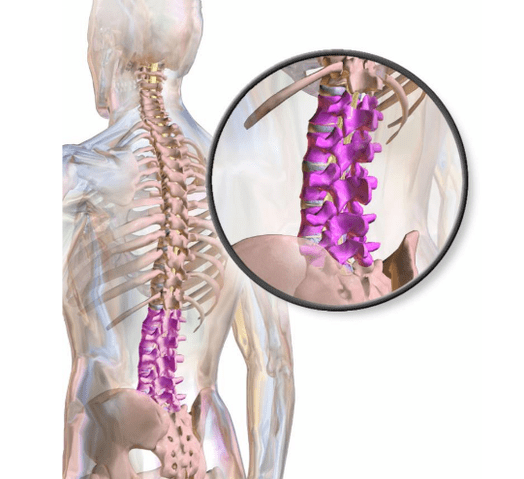
The upper lower back (lumbar spine) is connected to the upper back (thoracic spine) and the sacrum below the pelvis. The waistband is flexible enough to bend, twist and bend, and provides strength when standing, walking and lifting. Thus, the lower back is involved in almost all daily activities. Back pain can interfere with various activities and worsen the quality of life.
Types of back pain
Common types of back pain are localized, radiation, and back pain.
Local painappears in a certain part of the waist. It is the most common type of back pain. The cause is usually disc damage, arthritis of the joints and a less common muscle tension. The pain may be persistent and painful, or may be replaced by intermittent sharp pain at some point. Sudden pain may appear when the cause of the trauma. Local pain may increase or decrease with a change in position. Touching the back can be painful. Muscle spasm is possible.

Radiating painIt is a back pain that spreads to the feet. The pain can be dull or sharp and intense. Typically, it affects only the side or back of the foot and can extend to the foot or just the knee. Radiation pain is usually a manifestation of compression of the spinal nerve root in diseases such as herniated disc, sciatica, osteoarthritis or spinal stenosis. Coughing, sneezing, straining, or bending the legs straight can be painful. Pain when the spinal nerve root is compressed may be accompanied by weakness in the leg muscles, a feeling of bloating, or even loss of sensation. In rare cases, there is a loss of control of urination (urination) or loss of control of bowel movements (stool).
The pain was reflectedthe real cause of the pain is felt outside. For example, some people who have a heart attack experience pain in their left arm. The reflected pain in the internal organs of the lower back is mainly deep and painful in nature, and its exact location is difficult to determine. As a rule, with movement, the pain does not increase, unlike the pain that accompanies disorders of the musculoskeletal system.
Reasons
In most cases, back pain is a result of diseases of the spine and surrounding joints, muscles, ligaments and roots of the spinal nerves, as well as intervertebral discs. Often a single specific cause cannot be identified. Any painful spinal disease can cause a reflex contraction (spasm) of the muscles around the spine. Spasm can increase pain. Stress can aggravate back pain, but the mechanism is unclear.
Sometimes back pain is caused by a disease that does not affect a spine, such as spinal cancer, gynecological conditions (such as premenstrual syndrome), kidney disease (such as kidney stones), or urinary tract disease (such as kidney or bladder infections). , and prostate) and diseases of the digestive system (eg, diverticulitis), as well as large arteries located near the spine.
Common causes
Common causes of low back pain include:
- Osteoarthritis
- Compression fractures of the spine
- A torn or torn disc
- Narrowing of the lumbar spine
- Spondylolisthesis
- Damage to muscles and ligaments
- Fibromyalgia
Damagemay occur during normal activities (eg, lifting heavy objects, playing sports, unexpected movements) or as a result of an injury such as a fall or a car accident. Typically, imaging does not show any specific lesion, but doctors suspect that some muscles and / or ligaments are affected.
Osteoarthritis(degenerative arthritis) causes wear of the cartilage between the articular surfaces and the formation of bone spines (osteophytes). This disease is partly the result of years of tissue erosion. With severe degeneration and loss of disc neck, osteophytes in the hole can compress the roots of the spinal nerves. All these changes can cause stiffness as well as back pain.
Compression fractures of the spine (due to compression)(vertebral fractures) often occur when bone density decreases due to osteoporosis, which usually develops with age. However, fractures caused by osteoporosis occur in the upper and middle back and are accompanied by pain in these areas, not in the lower back.
A torn or torn disccan cause back pain. The disc is represented by a dense outer layer and a soft, jelly-like central part. If the disc is under constant stress from the vertebrae above and below (for example, when bending forward, especially when lifting heavy objects), tearing (tearing) the outer layer can cause pain.
Narrowing of the lumbar spine- Narrowing of the spinal canal in the lumbar region (containing a bundle of nerves passing through the center of the spine and extending downwards from the spinal cord and the lower part of the spinal cord). It is a common cause of back pain in the elderly. Spinal stenosis also develops in middle-aged people with congenital narrowing of the spinal canal. Spinal stenosis is caused by diseases such as osteoarthritis, spondylolisthesis, ankylosing spondylitis and Paget's disease.
Spinal stenosis can cause sciatica as well as back pain.
Spondylolisthesis- partial displacement of the spine in the lower part of the spine. A type usually occurs during adolescence or adolescence (often in athletes) and causes an injury that breaks a part of the spine. If both sides of the vertebrae are affected, it can move over the vertebrae below the vertebrae. Spondylolisthesis can also occur in the elderly, but can occur mainly as a result of degenerative disease. The risk of spinal stenosis in the lumbar region increases with the development of spondylolisthesis in adulthood.
FibromyalgiaIt is a common cause of pain that affects many parts of the body, including the lower back. This condition results in chronic diffuse pain in the muscles outside the waist and other soft tissues. Fibromyalgia is also characterized by sleep disturbances and fatigue.
Surveys
Because most back pain is caused by osteoarthritis, sprains, or other minor musculoskeletal disorders, tests are generally not scheduled and are eliminated within 6 weeks. Image tests are often needed:
- another reason is suspected;
- there are warning signs;
- back pain continues.
An assessment may also be ordered if there is no response to initial treatment or if symptoms worsen or change.
X-rays of the lumbar spine can only provide an image of the bones. These images may reveal degenerative changes due to osteoarthritis, spinal compression fractures, spondylolisthesis, and ankylosing spondylitis. However, magnetic resonance imaging (MRI) or computed tomography can provide a clear view of the bones and show soft tissues (including discs and some nerves) as is typical for MRI. An MRI or CT scan is usually needed when doctors determine that there are concerns and soft tissue diseases that are causing some changes in bone structure.
If you suspect a spinal cord compression, an MRI is performed as soon as possible. In rare cases, CT myelography is required when MRI results are ambiguous. In rare cases, if a malignant tumor or infection is suspected, a tissue sample (biopsy) should be taken for analysis. In some cases, electromyography and nerve conduction tests are performed to confirm the presence, localization, and in some cases the duration and severity of compression of the spinal nerve root.
Prophylaxis
People can reduce the risk of developing back pain by taking the following measures:
- physical exercises;
- exercises to strengthen and stretch muscles;
- maintaining a normal body weight;
- maintaining proper posture;
- compliance with recommendations for safe lifting of weights.
The most effective way to prevent back pain is regular exercise. Aerobic exercise and special exercises for the development of muscle strength and stretching are recommended.
Aerobic exercise, such as swimming and walking, improves overall physical fitness and strengthens muscles.
Special exercises to develop muscle strength and stretch the abdominal wall, thigh and lumbar muscles (deep muscles of the torso) allow you to stabilize the spine and reduce the elongation of the spinal column and ligaments. hold them.
Strength training includes pelvic flexion and abdominal flexion. Traction exercises include stretching with the knees bent at the chest. In some people, stretching exercises can increase back pain, so you need to be careful. The basic rule is that any exercise that causes or worsens back pain should be stopped. Exercises should be repeated until you feel mild (but not excessive) muscle fatigue. Breathing is important during exercise. People with back pain should consult a doctor before exercising.
Pelvic curve Keep your knees bent, your heels on the floor, and your heels in a supine position. Press your back to the ground, tense your hips (lift half an inch above the floor) and tense your abdominal muscles. Hold this position up to 10. Repeat 20 times. |
 |
False creaks Lie down with your knees bent and your feet flat on the floor. Bend your arms over your chest. Tighten your abdominal muscles, keeping your head straight (your chin should not touch your chest) and slowly lift your shoulders about 10 centimeters off the ground. Relax your abdominal muscles, slowly lower your shoulders. Do 3 sets of 10 repetitions. |
 |
Extend your knees to your chest Stand up, straighten up. Place both palms under one knee and press them to your chest. Hold up to 10 positions. Slowly lower your leg and repeat the exercise on the other leg. Do the exercise 10 times. |
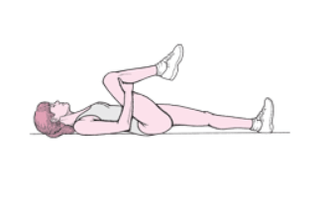 |
Exercise also makes it easier to maintain the desired body weight. Exercise also helps maintain bone density. Thus, exercise can reduce the risk of developing two conditions that can cause back pain: obesity and osteoporosis.
Proper posture while standing and sitting reduces back stress. You need to avoid getting caught. The seats should be adjusted in height so that the legs are straight on the floor, the knees are slightly bent and the lower chair is bent behind the chair. If the chair does not support the back, a pillow can be placed under it. When sitting, it is recommended to put your feet on the floor, not crosswise. Sick people should not stand or sit for long periods of time. If you have to stand or sit for long periods of time, frequent shifts can reduce the load on your back.
Treatment
If a specific cause can be identified, the disease is treated. For example, antibiotics are used to treat prostate infections. However, there is no cure for the pain caused by sprains or other conditions in the musculoskeletal system. However, the situation can be improved through general measures. Typically, such measures are also used when compressing the spinal nerve root.
General measures for back pain
Possible measures include:
- Making changes in activities
- To take painkillers
- Apply heat or cold to the painful area
- Light sports if endured
Treatment for newer back pain begins with eliminating activities that strain and cause back pain, such as lifting weights and bending. Bed rest does not speed up pain relief, and most experts recommend light work. Bed rest should not exceed 1 or 2 days to relieve severe pain. Prolonged bed rest weakens the core muscles and increases stiffness, worsens back pain and slows recovery. Corsets and traction are ineffective. Traction can slow healing.
Over-the-counter or over-the-counter anti-inflammatory drugs (NSAIDs) can reduce inflammation by relieving pain. Opioid analgesics are sometimes prescribed when NSAIDs do not provide sufficient analgesia, but long-term use of opioid analgesics can increase pain sensitivity, cause side effects, and increase the risk. addiction and dependence.
Muscle relaxants can sometimes relieve muscle spasms, but the effects are questionable. These medications are not recommended for elderly patients who are more likely to develop side effects such as drowsiness and disorientation. Doctors try not to prescribe muscle relaxants unless the patient has visible and palpable muscle spasms. If muscle relaxants are prescribed, they should not be used for more than 72 hours. Doctors sometimes recommend taking them before bedtime.
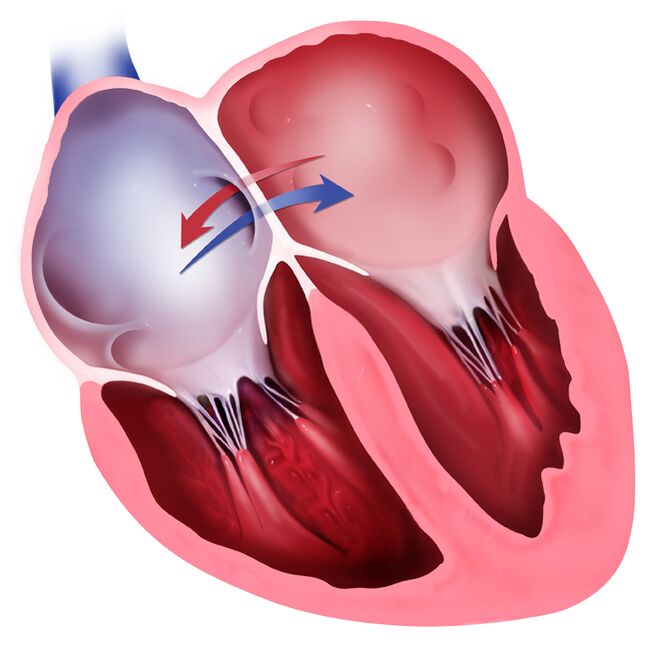
Massage can provide some temporary relief from back pain. Some studies have shown positive results in acupuncture, while others have contradicted these findings. Spinal manipulation by chiropractors or other physicians (such as osteopathic physicians) can also reduce pain in conjunction with an exercise program. However, spinal manipulation can increase the risk of additional injury and should be avoided in individuals with inflammatory arthritis, a neck problem that causes cervical instability, or a herniated disc.
It is recommended to sleep comfortably on a medium firm mattress. People lying on their backs should have a pillow under their knees. Patients lying on their side should use a pillow that allows them to keep their head in a neutral position (without bending the neck up or down). Patients should place a second pillow between their knees with their knees and hips slightly bent if they are relieving back pain. Patients can still sleep on their stomachs if they feel comfortable.
Continue or start other preventive measures (correct posture, appropriate weight lifting techniques). When such events occur, attacks of back pain usually disappear in a few days to 2 weeks. Regardless of treatment, 80-90% of these attacks resolve within 6 weeks.
Treatment of chronic low back pain
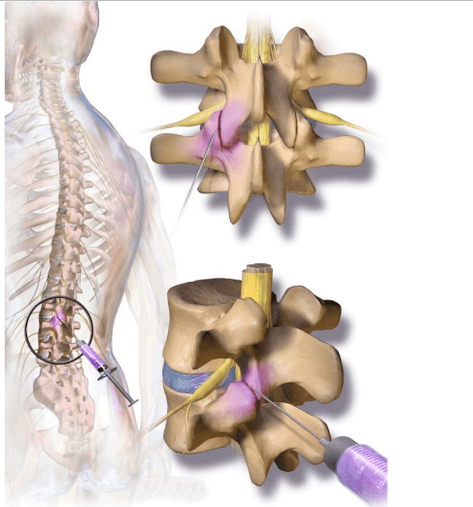
Additional measures are needed to treat chronic low back pain. It is recommended to do aerobic exercise and lose weight if necessary. If analgesics are ineffective, other treatments should be prescribed.
Transcutaneous electroneurostimulation (TENS) is possible. CHENS devices generate a weak alternating current, which causes a slight tingling sensation. This current can prevent some of the pain from being transmitted from the spinal cord to the brain. It can be applied to the painful area several times a day, the duration of the session is from 20 minutes to several hours, depending on the severity of the pain.
Sometimes, under local anesthesia, corticosteroids are periodically injected into the facet joint of the spine or into the epidural space - between the spine and the outer layer of tissue surrounding the spinal cord. Epidural injections may be more effective for sciatica, which is more likely to cause a herniated disc than lumbar stenosis. However, they may not have a long-term beneficial effect. They usually only last a few days or weeks. Their main goal is to reduce pain so that you can exercise for long-term pain relief.
Back pain surgery
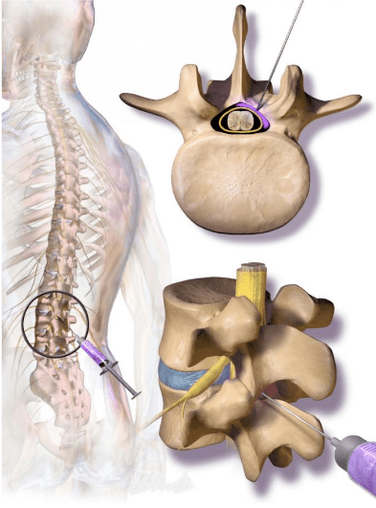
In cases where the herniated disc causes persistent or chronic sciatica, weakness, loss of sensation, or incontinence, it may be necessary to surgically remove the protruding portion of the disc (discectomy) and, in some cases, a portion of the vertebra. (laminectomy).
In severe spinal stenosis, a large portion of the posterior vertebrae (lamellae of the vertebral arch) can be removed to expand it (lumbar laminectomy). General anesthesia is generally needed. The hospital stay is usually 4-5 days. Patients will be able to return to normal activities in 3-4 months. Adequate or complete recovery is observed in about two-thirds of patients. For other patients, such surgery can prevent the worsening of pain and other symptoms.
If the spine is unstable (this can result in a severe herniated disc, spondylolisthesis, or laminectomy for spinal stenosis), spinal fusion (called arthrodesis of the spine) can be performed. However, fusion limits mobility, can be accompanied by excessive mechanical stress on the rest of the spine, and can cause problems in the future.
Compression fractures of the spine
Spinal fractures are very common in women over 50 years of age. It will not help the bones to heal, but can be treated without surgery with braces, painkillers, and possibly calcitonin nasal spray, which can reduce pain.
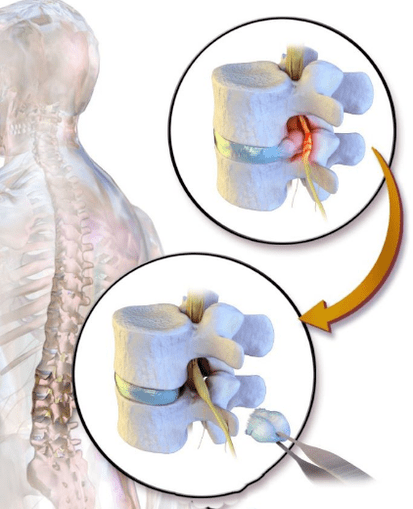
If adequate pain control cannot be achieved, two surgical options are available:
- Vertebroplasty: injection of cement mortar into a broken bone.
- Kyphoplasty: Insert a balloon into a broken bone to create a gap. The balloon is then filled with cement.
However, recent studies have shown that in the long run, the effectiveness of these surgical procedures does not outweigh the effects of non-surgical treatment options.
Highlights
- Low back pain is common. It is usually caused by diseases of the musculoskeletal system of the spine and factors such as fatigue, obesity and insufficient physical activity.
- Low back pain is rarely severe at a young age, and testing is generally unnecessary when symptoms do not last for several weeks.
- Patients with warning signs or over 55 should seek medical attention immediately.
- Strengthening the abdominal wall and back muscles with special exercises prevents the most common types of back pain.
- For low back pain, in most cases, adequate treatment is to exclude measures that cause mechanical effects on the back, to take painkillers, and in some cases to apply a cold or hot compress.
- Prolonged bed rest and stretching can delay recovery.
- In severe cases, such as abnormal sensations and weakness in the legs, surgery may be required.
- Compression fractures of the vertebrae can be treated conservatively (with braces, painkillers and nasal sprays) or, in some cases, surgery.



































